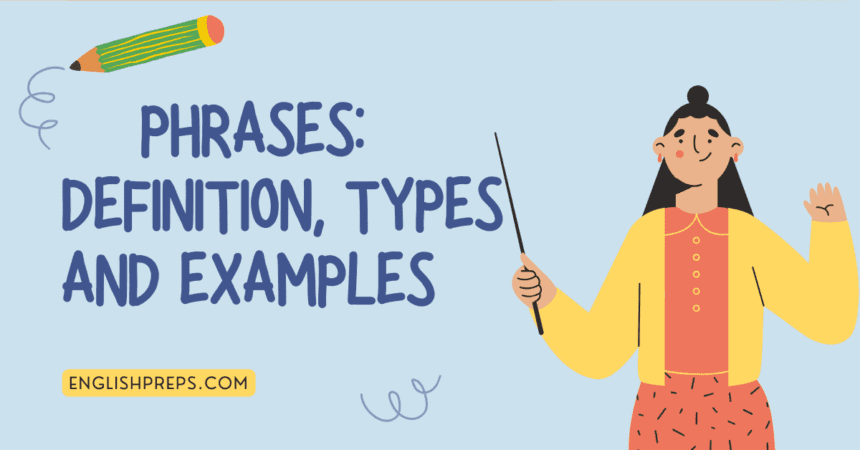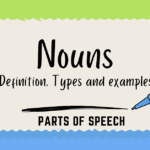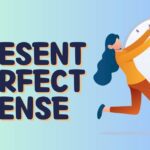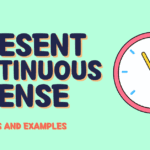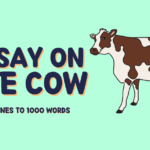A phrase is a group of words that does not contain a subject and verb and does not express a complete thought. It functions as a unit within a sentence and usually does not contain a subordinating conjunction. Phrases are used to add structure and depth to sentences, and they can be either restrictive or nonrestrictive.
There are several types of phrases, including noun phrases, verb phrases, prepositional phrases, participial phrases, gerund phrases, and infinitive phrases.
Before we get into Phrase types, it’s important to know the main difference between phrase and clause. Here are some key differences between phrases and clauses:
- Completeness: A clause expresses a complete thought and can stand on its own as a sentence, while a phrase does not express a complete thought and cannot stand alone as a sentence.
- Subject and verb: A clause contains a subject and a verb, while a phrase does not.
- Subordinating conjunction: A dependent clause (also known as a subordinate clause) begins with a subordinating conjunction such as “because,” “while,” or “although,” while a phrase does not contain a subordinating conjunction.
- Function in a sentence: A clause can function as a subject, predicate, direct object, indirect object, object of a preposition, or adjective or adverb modifying a noun or verb, while a phrase can function as a noun, verb, adjective, or adverb.
Here is an example that illustrates these differences:
- “I went to the store, which is located downtown, to buy some milk.”
“I went to the store” is an independent clause because it contains a subject (“I”) and a verb (“went”) and expresses a complete thought. It functions as the predicate of the sentence.
“which is located downtown” is a dependent clause because it begins with a subordinating conjunction (“which”) and cannot stand on its own as a complete sentence. It functions as an adjective modifying the noun “store.”
“to buy some milk” is an infinitive phrase because it begins with the infinitive “to buy” and does not contain a subject or a verb. It functions as an adjective modifying the noun “store.”
Types of Phrases
There are several types of phrases, including:
Noun phrase
A noun phrase is a group of words that functions as a noun in a sentence. It typically consists of a noun, which is the head of the phrase, and any determiners, modifiers, or other words that come before or after the noun.
For example:
- “The red car” is a noun phrase. “The” is a determiner, “red” is an adjective modifying the noun “car”, and “car” is the head noun.
- “The book on the table” is a noun phrase. “The” is a determiner, “book” is the head noun, “on” is a preposition, “the” is a determiner, and “table” is a noun serving as the object of the preposition.
Noun phrases can function as the subject, direct object, indirect object, or object of a preposition in a sentence. For example:
- “The red car drove down the street.” – “The red car” is the subject of the sentence.
- “I saw the book on the table.” – “the book on the table” is the direct object of the verb “saw”.
- “She gave the gift to her friend.” – “the gift” is the direct object and “her friend” is the indirect object of the verb “gave”.
- “I put the keys in the drawer.” – “the keys” is the direct object and “in the drawer” is the prepositional phrase serving as the object of the preposition “in”.
Verb phrase
A verb phrase is a group of words that functions as a verb in a sentence. It typically consists of a main verb and any auxiliary verbs that come before or after it.
For example:
- “I am going to the store.” – “going” is the main verb and “am” is the auxiliary verb.
- “She has been waiting for the bus for an hour.” – “been waiting” is the main verb and “has” is the auxiliary verb.
Verb phrases can express tense, mood, aspect, and voice. Tense refers to the time frame in which the verb’s action takes place, such as past, present, or future. Mood refers to the attitude or attitude of the speaker towards the verb’s action, such as indicative, imperative, or subjunctive. Aspect refers to the progression or completion of the verb’s action, such as perfect, progressive, or habitual. Voice refers to the relationship between the verb’s action and the subject, such as active or passive.
For example:
- “I am going to the store.” – “am going” is the verb phrase in the present tense, indicative mood, progressive aspect, and active voice.
- “She had been waiting for the bus for an hour.” – “had been waiting” is the verb phrase in the past tense, indicative mood, perfect aspect, and active voice.
- “If I were you, I would go to the store.” – “were” and “would go” are the verb phrases in the past subjunctive mood, indicating a hypothetical or contrary-to-fact situation.
- “The store was being built by the workers.” – “was being built” is the verb phrase in the past tense, indicative mood, progressive aspect, and passive voice.
Adjective phrase
An adjective phrase is a group of words that functions as an adjective in a sentence. It typically consists of an adjective, which is the head of the phrase, and any modifying words that come before or after it.
For example:
- “The happy dog wagged its tail.” – “happy” is the adjective modifying “dog”.
- “The old man with the cane walked slowly.” – “old” is the adjective modifying “man”, and “with the cane” is a prepositional phrase modifying “man”.
Adjective phrases can come before or after the noun they modify in a sentence. For example:
- “The big, fluffy dog barked at the mailman.” – “big” and “fluffy” are adjectives modifying “dog”.
- “The dog barked at the tall, thin mailman.” – “tall” and “thin” are adjectives modifying “mailman”.
Adjective phrases can also be modified by adverbs, which provide additional information about the adjective. For example:
- “The extremely happy dog wagged its tail.” – “extremely” is an adverb modifying the adjective “happy”.
- “The dog wagged its tail very happily.” – “very” is an adverb modifying the adjective “happy”.
Adverbial phrase
An adverbial phrase is a group of words that functions as an adverb in a sentence. It typically consists of an adverb, which is the head of the phrase, and any modifying words that come before or after it.
Adverbial phrases can provide information about the verb, such as the time, place, manner, or frequency of the verb’s action. They can also modify adjectives, other adverbs, or whole clauses.
For example:
- “He speaks fluently.” – “fluently” is an adverb modifying the verb “speaks”.
- “She sings beautifully.” – “beautifully” is an adverb modifying the verb “sings”.
- “We went to the store yesterday.” – “yesterday” is an adverb modifying the verb “went”.
- “The dog barked loudly.” – “loudly” is an adverb modifying the verb “barked”.
- “She is very happy.” – “very” is an adverb modifying the adjective “happy”.
- “He runs extremely fast.” – “extremely” is an adverb modifying the adverb “fast”.
- “I will do it as soon as possible.” – “as soon as possible” is an adverbial phrase modifying the verb “do”.
Adverbial phrases can also be prepositional phrases, infinitive phrases, participle phrases, or absolute phrases. For example:
- “I will do it in the morning.” – “in the morning” is a prepositional phrase functioning as an adverb.
- “He wants to go to the store.” – “to go to the store” is an infinitive phrase functioning as an adverb.
- “She is singing while cooking dinner.” – “while cooking dinner” is a participle phrase functioning as an adverb.
- “The door open, she walked in.” – “The door open” is an absolute phrase functioning as an adverb modifying the verb “walked”.
Prepositional phrase
A prepositional phrase is a group of words that begins with a preposition and ends with a noun or pronoun, which is called the object of the preposition. The object of the preposition is modified by any adjectives or other modifying words that come before it.
For example:
- “I sat on the couch.” – “on the couch” is a prepositional phrase, with “on” as the preposition and “couch” as the object of the preposition.
- “She looked at the beautiful sunset.” – “at the beautiful sunset” is a prepositional phrase, with “at” as the preposition, “sunset” as the object of the preposition, and “beautiful” as an adjective modifying “sunset”.
Prepositional phrases can function as adjectives, modifying nouns or pronouns, or as adverbs, modifying verbs, adjectives, or other adverbs. For example:
- “The book on the table is mine.” – “on the table” is a prepositional phrase modifying “book” as an adjective.
- “I put the keys in the drawer.” – “in the drawer” is a prepositional phrase modifying “put” as an adverb.
- “She is the woman with the red hat.” – “with the red hat” is a prepositional phrase modifying “woman” as an adjective.
- “He runs faster than I do.” – “than I do” is a prepositional phrase modifying “runs” as an adverb.
Some common prepositions include “in”, “on”, “at”, “by”, “with”, “to”, “for”, “from”, “of”, “over”, “under”, “between”, and “among”. Prepositions often express spatial or temporal relationships, such as location, direction, or time.
Infinitive phrase
An infinitive phrase is a group of words that begins with an infinitive, which is the base form of a verb preceded by the word “to”. The infinitive phrase can include any modifying words that come before or after the infinitive.
For example:
- “To swim is fun.” – “To swim” is the infinitive phrase, with “swim” as the infinitive and “to” as the marker.
- “I want to go to the store.” – “to go to the store” is the infinitive phrase, with “go” as the infinitive and “to” as the marker.
Infinitive phrases can function as nouns, adjectives, or adverbs in a sentence. When they function as nouns, they can serve as the subject, direct object, or subject complement of a verb. When they function as adjectives, they can modify nouns or pronouns. When they function as adverbs, they can modify verbs, adjectives, or other adverbs.
For example:
- “To swim is fun.” – “To swim” is the infinitive phrase functioning as the subject of the verb “is”.
- “I want to go to the store.” – “to go to the store” is the infinitive phrase functioning as the direct object of the verb “want”.
- “His goal is to become a doctor.” – “to become a doctor” is the infinitive phrase functioning as the subject complement of the verb “is”.
- “The movie to watch is on TV.” – “to watch” is the infinitive phrase modifying “movie” as an adjective.
- “I am eager to try the new restaurant.” – “to try the new restaurant” is the infinitive phrase modifying “eager” as an adjective.
- “He runs faster than I do.” – “to do” is the infinitive phrase modifying “than” as an adverb.
Gerund phrase
A gerund phrase is a group of words that begins with a gerund, which is a verb form that ends in “-ing” and functions as a noun. The gerund phrase can include any modifying words that come before or after the gerund.
For example:
- “Swimming is fun.” – “Swimming” is the gerund phrase, with “swimming” as the gerund.
- “I enjoy swimming.” – “swimming” is the gerund phrase, with “swimming” as the gerund.
Gerund phrases can function as the subject, direct object, or object of a preposition in a sentence. They can also be modified by adjectives or other modifying words.
For example:
- “Swimming is fun.” – “Swimming” is the gerund phrase functioning as the subject of the verb “is”.
- “I enjoy swimming.” – “swimming” is the gerund phrase functioning as the direct object of the verb “enjoy”.
- “The pool is for swimming.” – “for swimming” is the gerund phrase functioning as the object of the preposition “for”.
- “The swimming pool is heated.” – “swimming” is an adjective modifying “pool”.
- “I am interested in studying biology.” – “studying biology” is the gerund phrase, with “studying” as the gerund and “biology” as the object of the gerund.
Gerunds are often used to describe actions or activities as events or concepts, rather than as specific occurrences. They can also be used to form continuous verb tenses, such as the present continuous and the past continuous.
Participle phrase
A participle phrase is a group of words that begins with a participle, which is a verb form that can be used as an adjective. Participles can be either present participles, which end in “-ing”, or past participles, which typically end in “-ed”, “-en”, or “-t”. The participle phrase can include any modifying words that come before or after the participle.
For example:
- “Running late, I forgot my keys.” – “Running late” is the participle phrase, with “running” as the present participle and “late” as an adjective modifying “running”.
- “The broken vase was glued back together.” – “broken” is the participle phrase, with “broken” as the past participle.
Participle phrases can function as adjectives, modifying nouns or pronouns. They can also be used to form continuous verb tenses, such as the present continuous and the past continuous.
For example:
- “The smiling child waved at me.” – “smiling” is the participle phrase modifying “child” as an adjective.
- “The flowers blooming in the garden are beautiful.” – “blooming in the garden” is the participle phrase modifying “flowers” as an adjective.
- “I am reading a book.” – “reading” is the participle phrase forming the present continuous verb tense “am reading”.
- “He was walking to the store.” – “walking to the store” is the participle phrase forming the past continuous verb tense “was walking”.
Participle phrases are often used to describe the circumstances or the result of an action or event. They can also be used to provide additional information about the noun or pronoun they modify.
Conjunctional phrase
A conjunctional phrase is a group of words that begins with a conjunction and includes any modifying words that come before or after it. Conjunctions are words that join words, phrases, or clauses together.
For example:
- “I will eat the pizza, or I will have a salad.” – “or” is the conjunction linking the two clauses “I will eat the pizza” and “I will have a salad”.
- “She likes to play soccer, and she is good at it.” – “and” is the conjunction linking the two clauses “She likes to play soccer” and “she is good at it”.
Conjunctions can be coordinating conjunctions, which join words, phrases, or clauses that are grammatically equal, or subordinating conjunctions, which join a dependent clause to an independent clause. Coordinating conjunctions include “and”, “but”, “or”, “nor”, and “yet”. Subordinating conjunctions include “because”, “since”, “after”, “before”, “although”, “though”, “as”, and “while”.
For example:
- “I will eat the pizza, or I will have a salad.” – “or” is a coordinating conjunction joining the two clauses.
- “I will eat the pizza because I am hungry.” – “because” is a subordinating conjunction joining the dependent clause “because I am hungry” to the independent clause “I will eat the pizza”.
Conjunctional phrases can be used to show the relationship between the words, phrases, or clauses they join. They can also be used to add emphasis or to provide additional information.
Interjectional phrase
An interjectional phrase is a group of words that expresses strong emotion or surprise and is used to interrupt the flow of a sentence. It typically begins with an interjection, which is a word or phrase that stands alone as a separate syntactic entity and is used to express emotion or surprise. Interjections are not grammatically connected to the rest of the sentence and are often followed by exclamation points or question marks.
For example:
- “Oh no, I left my keys at the office!” – “Oh no” is the interjectional phrase, with “Oh” as the interjection.
- “Wow, that was amazing!” – “Wow” is the interjectional phrase, with “Wow” as the interjection.
Some common interjections include “oh”, “ah”, “wow”, “hey”, “yuck”, “oops”, and “hmm”. Interjections can be used to convey a wide range of emotions, such as happiness, sadness, excitement, frustration, or surprise.
Interjectional phrases are not essential to the meaning of a sentence and can often be removed without changing the basic structure or meaning of the sentence. They are used to add emphasis or to convey the speaker’s emotional state.
For example:
- “Oh no, I left my keys at the office!” – The interjectional phrase “Oh no” adds emphasis to the speaker’s realization that they left their keys at the office.
- “I’m sorry, but I can’t come to the party.” – The interjectional phrase “I’m sorry” conveys the speaker’s apology for not being able to come to the party.
Appositive phrase
An appositive phrase is a noun or noun phrase that renames or explains another noun or noun phrase that comes before it. It is set off by commas or parentheses and is not essential to the basic structure or meaning of the sentence.
For example:
- “My neighbor, a doctor, is coming over for dinner.” – “a doctor” is the appositive phrase, renaming “my neighbor”.
- “My favorite book, To Kill a Mockingbird, is about racism and injustice.” – “To Kill a Mockingbird” is the appositive phrase, renaming “my favorite book”.
Appositive phrases can provide additional information about the noun or noun phrase they rename, such as the person’s occupation, title, or characteristics. They can also be used to add emphasis or to provide further clarification.
For example:
- “My friend, the mayor of our town, is coming to visit.” – The appositive phrase “the mayor of our town” provides additional information about “my friend” and adds emphasis to their status as the mayor.
- “The Mona Lisa, a famous painting by Leonardo da Vinci, is on display at the Louvre.” – The appositive phrase “a famous painting by Leonardo da Vinci” provides further clarification about “The Mona Lisa” and adds context to its significance.
Appositive phrases can come before or after the noun or noun phrase they rename, depending on the emphasis or information being conveyed. They are useful for providing additional details or context about a noun or noun phrase in a sentence.
Absolute phrase
An absolute phrase is a group of words that modifies a noun or pronoun in a sentence, but is not directly connected to the rest of the sentence grammatically. It typically consists of a noun or pronoun and a participle or participle phrase, and is set off by a comma or a pair of commas.
For example:
- “The door open, she walked in.” – “The door open” is the absolute phrase, modifying “she” and providing additional information about the circumstances of her walking in.
- “He finished the marathon, his legs sore and tired.” – “his legs sore and tired” is the absolute phrase, modifying “he” and providing additional information about his physical condition after finishing the marathon.
Absolute phrases can provide additional information about the circumstances, conditions, or characteristics of the noun or pronoun they modify, but they are not essential to the basic structure or meaning of the sentence. They can be used to add emphasis or to provide further clarification.
For example:
- “The project complete, we can finally relax.” – The absolute phrase “the project complete” provides additional information about the circumstances of the speaker being able to relax and adds emphasis to the completion of the project.
- “The sun setting, we decided to call it a day.” – The absolute phrase “the sun setting” provides additional information about the time of day and adds context to the decision to call it a day.
Absolute phrases are useful for providing additional details or context about a noun or pronoun in a sentence, but they are not essential to the basic meaning of the sentence. They can be removed without changing the basic structure or meaning of the sentence.
Conclusion
In conclusion, phrases are an integral part of the English language, providing structure and depth to our communication. From noun phrases that act as the subject or object of a sentence, to verb phrases that convey action, to adjective and adverb phrases that add description, these word groups play a vital role in our ability to express ourselves effectively. Prepositional phrases, with their ability to establish relationships between words and ideas, also contribute to the richness of our language. By understanding the different types of phrases and their functions, we can craft clear and concise sentences that convey our thoughts and ideas with precision and impact.



